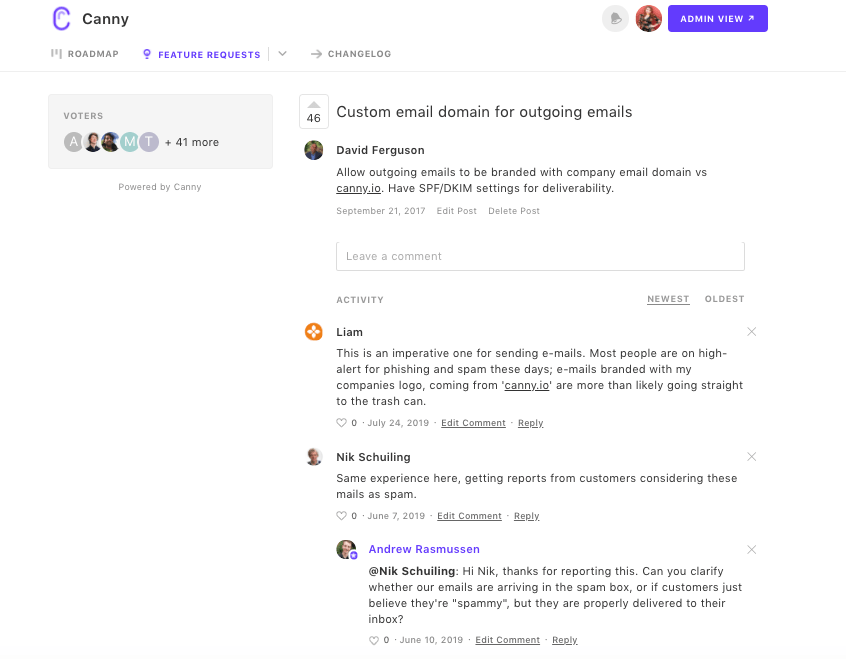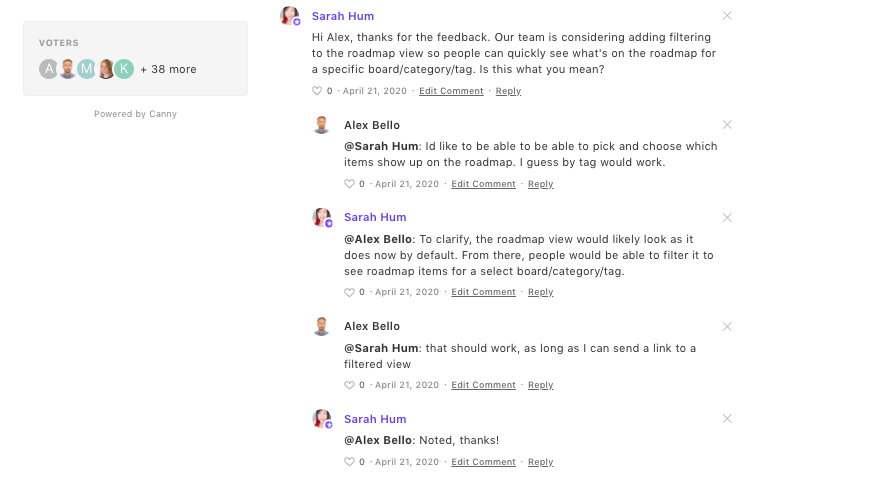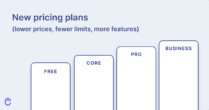Are you asking for product feedback and ending the conversation there? If so, you’re missing out on tons of valuable information.
It isn’t enough to just ask your customers what features or improvements they’d like to see.
Collecting this type of customer feedback is where you should start. But from there, it’s important to ask the right types of customer feedback questions.
Asking the right questions gets to the root of what your customers want to see from your product. It helps you uncover the “why.”
Feedback starts the conversation
When your customers ask for a feature or comment on your product, they’re giving you valuable information.
But, it’s just the beginning of what should become a dialogue with your customers.
Feedback requires follow up. It’s important to ask questions.
Why is it important to ask follow-up questions after customers offer feedback?
If you don’t follow up, ask questions, and get more details, you could misinterpret customer feedback.
You might miss something important. Or, you could wind up building something that only half-solves your customer’s problem.

An example from within our Canny feedback board: Andrew’s follow-up question asks for more detail on the issue. You can see the full discussion here.
Broadly, asking questions after customers offer feedback matters for the following reasons:
- It helps you understand their request better.
- You may be able to suggest a workaround and avoid building something new.
- It gives you a chance to dive deeper and better understand how they’re using your product.
- Customers might say “we want X,” but what they really want is a solution to their problem, not X exactly. Asking questions helps you get the whole picture. (Think “building a faster horse”.)
A note on collecting feedback
In this article, I’ll be discussing customer feedback questions under the premise that you’re using a feedback board like Canny.
With Canny, you can respond directly to feedback, and ask follow-up questions. Customers who submitted the request will be notified, and they’ll be able to respond easily, starting a dialogue.
That said, there are other ways you might be collecting feedback. Asking questions is critical, regardless of the method you’re currently using. (We’ve also written about how to decide if a feedback tool is right for you.) You can choose to do this via email follow up, or when you’re chatting with customers on social media, on the phone, and so on.
Of course, we think you should be using Canny to track, manage, and respond to feedback. It’s the easiest, most transparent way to find out what your customers want, and dig deeper.
But the most important thing is that you’re listening to your customers, and asking the right questions.
Okay, now that that’s out of the way—let’s dive in.
5 valuable customer feedback questions to ask
1. Why do you need [feature/change]?
Start basic. Begin with “why.”
Other ways to ask this question:
- What will this help you do better?
- How would you use [feature/change]?
Why this question matters:
Asking questions like this helps you better understand how your customers use your product. It also shows what the suggested change would help them do faster, better, or differently.
It’s an easy way to open up a dialogue. If a customer asks for X, start by finding out why they want X.
2. Any reason why [existing feature/aspect of the product] doesn’t work for you?
We ask this a lot. It’s one of the most valuable questions you can ask your customers when they request specific features.

An example of this question in action (see the full discussion on our feedback board here).
Other ways to ask this:
- Have you tried [XYZ way of using the tool]?
Why this question matters:
Asking this gives customers a chance to explain why the current features aren’t getting the job done.
Maybe they have a compelling argument. Maybe not.
If it’s the former, you’ll learn why your current feature set isn’t doing what they need it to do. In the latter case, you’ll have the opportunity to show them how they can use your current features to accomplish their goal.
Either way, you’ll learn something. You’ll get richer information than you’d have gotten if you took their feedback at face value without digging deeper. And, you might avoid wasting time building something for a problem that could technically be solved a different way.
3. What’s the end goal?
Instead of focusing on what the customer has decided is the best solution, this question shifts the conversation to the desired outcome.
Again, it’s not about building a faster horse—even if what they ask for is faster horses.
Other ways to ask this question:
- What outcome are you hoping to achieve?
Why this question matters:
Your customers might be able to clearly suggest a specific solution. But, what’s more important is what they’re trying to do.
It’s not on them to tell you what new features to build. You are the one in the best position to do that.
Once you know where they want to go, you can decide what you need to build to get them there. Not the other way around.
4. How often do you do X?
This question helps you understand how big of an issue something is.
Other ways to ask this question:
- Is X an issue you run into often/how often?
Why this question matters:
If it’s a problem customers have infrequently, it might not need solving right away (or at all). Maybe it’s something that you’d be better off suggesting a workaround for.
But, if it’s a pain that customers run into on a very frequent basis, it’s worth giving attention. A problem your customer base is having daily might warrant more of your energy than a problem they have once.
It’s helpful information when it comes to prioritizing requests. You can’t necessarily know the issue frequency unless you follow up and ask, though.
5. We’re considering doing [XYZ]. Is this what you had in mind?
You might already have a new feature or change in mind that’s somewhat in line with what customers are asking for.
Here is a chance to find out if what you’re envisioning lines up with what they need.
Other ways to ask this question:
- Would [suggested new change/feature] solve your problem?
Why this question matters:
Let’s say you’ve already had a chance to ask some questions, and you’ve gotten a clear sense of why a request would add value. So, you begin to flesh out an outline of what the new feature or fix would look like. In this case, this is a good question to finish out the conversation with.
This is another question we ask at Canny pretty often:

You can read the full conversation on our Canny feedback board here.
Asking this question helps clarify if you’ve understood feedback correctly. You’ll find out if you’ve interpreted the customer’s goal in the way they intended.
And, you’ll learn if the way you’ve laid out solving their problem actually solves it.
It might need some tweaks. You have a chance to iterate. But, you haven’t wasted time building something that isn’t quite what your customer base actually needs.
Understand what your customers are trying to do—not what they think you should build
These questions are all different ways of getting to the same outcome: uncovering how your customer uses your product, and what their end goals are.
It moves feedback away from surface-level feature requests. Feedback becomes rich insight into how your customers are actually using your product, and what they need from it.
Use initial feedback as a jumping-off point for a deeper conversation. It’s not one-and-done. It’s the beginning of a dialogue that allows you to better understand your customer’s real needs.






